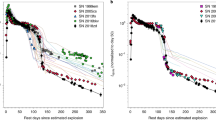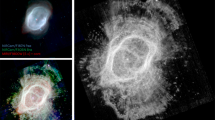Abstract
VERY few nearby supernovae have been bright enough to see with the naked eye. The only such case this century was supernova 1987A. Matching historical records of such events with presently observable remnants allows accurate estimates to be made of the age and incidence rate of supernovae; ancient Chinese astronomical records are a particularly valuable resource for this purpose. The Houhanshu1 of the Later Han dynasty records the appearance of a 'guest star' in AD 185. This is widely regarded as the oldest supernova recorded historically, and several candidate remnants have been suggested2,3, in particular the object RCW862. Here we show that a reinterpretation of the relevant passage in the Houhan-shu is inconsistent with the supernova interpretation, but suggests instead that the guest star was a comet. Our findings indicate that some of the keywords used by Chinese astronomers in historical records must be interpreted with caution.
This is a preview of subscription content, access via your institution
Access options
Subscribe to this journal
Receive 51 print issues and online access
$199.00 per year
only $3.90 per issue
Buy this article
- Purchase on Springer Link
- Instant access to full article PDF
Prices may be subject to local taxes which are calculated during checkout
Similar content being viewed by others
References
Fan Yeh Houhanshu vol. 6, 3260 (Chung-hua, Hong Kong, 1971 reprint). (In Chinese.)
Clark, D. H. & Stephenson, F. R. The Historical Supernovae (Pergamon, Oxford, 1977).
Thorsett, S. E. Nature 356, 690–691 (1992).
Ho, P. Y. Vistas in Astronomy 5, 127–225 (1962).
Huang, Y.-L. & Moriarty-Schieven, G. H. Science 235, 59–60 (1987).
Yi Shitong Atlas comparing Chinese and Western Starmaps and Catalogues (Science Press, Beijing, 1981). (In Chinese.)
Yu Jicai Lingtai miyuan (in Vol. 807 of the collection of Sikuquanshu) Ch. 11, 4 (Taiwan Shang-wu, Taipei reprint). (In Chinese.)
Qutan Xida Kaiyuan zhanjing (in Vol. 807 of the collection of Sikuquanshu) (originally written about ad 729, Taiwan Shang-wu, Taipei reprint). (In Chinese.)
Chen Meng-Lei et al. Qianxiangdian of Gujin tushu jicheng Vol. 10, 53 (Ding-wen, Taipei reprint). (In Chinese.)
Yu Jicai Lingtai miyuan (in Vol. 807 of the collection of Sikuquanshu) Ch. 1, 18–20. (In Chinese.)
Qutan Xida Kaiyuan zhanjing (in Vol. 807 of the collection of Sikuquanshu) Ch. 64, 13–16. (In Chinese.)
Zheng Xuan Zhouli Ch. 41, 16 (Chung-hua, Taipei, 1966 reprint). (In Chinese.)
Fan Yeh Houhanshu Vol. 6, 3230–3244. (In Chinese.)
Fan Yeh Houhanshu Vol. 6, 3256. (In Chinese.)
Lundmark, K. Publs astr. Soc. Pacif. 33, 225–238 (1921).
Duyvendak, J. J. L. Publs astr. Soc. Pacif. 54, 91–94 (1942).
Mayall, N. U. & Oort, J. H. Publs astr. Soc. Pacif. 54, 95–104 (1942).
Schaefer, B. E. Publs astr. Soc. Pacif. 105, 1238–1239 (1993).
Strom, R. G. Mon. Not. R. astr. Soc. 268, L5–L9 (1994).
van den Bergh, S. & Tammann, G. A. A. Rev. Astr. Astrophys. 29, 363–407 (1991).
Kaastra, J. S., Asaoka, I., Koyama, K. & Yamauchi, S. Astr. Astrophys. 264, 654–660 (1992).
Scalo, J. M. Fundamentals of Cosmic Physics 11, 1–278 (1986).
Strom, R. G. Astr. Astrophys. 288, L1–L4 (1994).
Author information
Authors and Affiliations
Rights and permissions
About this article
Cite this article
Chin, YN., Huang, YL. Identification of the guest star of AD 185 as a comet rather than a supernova. Nature 371, 398–399 (1994). https://doi.org/10.1038/371398a0
Received:
Accepted:
Issue Date:
DOI: https://doi.org/10.1038/371398a0
This article is cited by
-
The identification of comets in Chinese historical records
Science China Physics, Mechanics and Astronomy (2011)
Comments
By submitting a comment you agree to abide by our Terms and Community Guidelines. If you find something abusive or that does not comply with our terms or guidelines please flag it as inappropriate.



